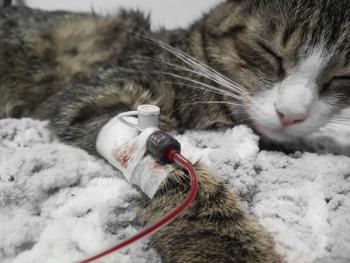
Supporting pet owning clients with cancer, and survivors
Practical suggestions for veterinary professionals
Cancer affects millions of Americans each year, with over 2 million new cases diagnosed in 2024 alone—resulting in approximately 5,500 cancer diagnoses and 1,600 deaths per day.1 While the medical community has increasingly recognized the impact of cancer on survivors’ relationships with their children, little attention has been paid to how cancer affects relationships between survivors and pets.
To better understand this important, but overlooked topic, we recruited cancer survivors between April 2024 – December 2024 via social media (i.e., Facebook, Twitter, Instagram, Reddit). Our sample included 930 cancer survivors, consisting of 265/882 (30%) people diagnosed with breast cancer, 220/882 (24.9%) with lung/bronchus cancer, 120/882 (13.6%) with prostate cancer, 70/882 (7.9%) with colorectal cancer, and 207/882 (23.5%) with other types of cancer. The largest percentages of participants were in Stage 1 (280/919, 30.5%) or Stage II (263/919, 28.6%), and the majority (722/919, 78.6%) reported currently receiving treatment or care. The most common type of treatment or care they were receiving included chemotherapy (341/930, 36.7%), followed by medication (e.g., tamoxifen/Nolvadex, aromatase inhibitors) (229/930, 24.6%), and radiotherapy (227/930, 24.4%). A smaller number reported undergoing any type of surgical procedure (112/930, 12.0%) or receiving hospice or palliative care (63/930, 6.8%). Most participants reported being diagnosed 2-12 months (256/930, 27.5%) or 1-2 years ago (206/930, 22.2%).
Findings from our study elucidated the most common concerns and benefits breast, prostate, colorectal and lung cancer survivors experience in caring for their pets during cancer treatment and/or recovery. Survivors reported that their pets provide them with emotional support, companionship, and motivation during treatment. In particular, 79% of participants reported that their pets create a "positive presence in the home", view their pets as "partners to relax with" (73%), make them “feel loved” (77%), and "offer the opportunity to care for another being" (69%). For many survivors, their pets were seen as a critical coping mechanism during treatment.
Participants overwhelmingly reported strong attachments to their pets. These strong bonds were associated with higher levels of reported support from their pets and higher levels of guilt when they felt unable to provide the care they wanted to give their pets. Many of our participants reported significant guilt about not meeting their pets' needs during treatment, similar to parental guilt experienced by those with children. This guilt can exacerbate anxiety and depression,2,3 potentially impacting treatment adherence and recovery. Yet daily tasks like walking their dogs, lifting heavy bags of food or litter, and cleaning up after their pets can become difficult or impossible during treatment. In addition, approximately 1/3 of participants reported being very or extremely concerned about the practical impact of cancer on their pets and who would care for their pet if they became unable due to cancer progression or death.
We found that certain populations faced greater challenges managing pet care during cancer treatment, including recently diagnosed patients (within 2 months), those under 30 years old, and those with young children. These demographic groups reported higher levels of concern and guilt regarding pet care during treatment.
When queried about support, approximately 2/3 of cancer survivors reported receiving support for pet-related needs from partners, family, and friends, but only half of the participants felt supported by their veterinarian or medical professionals.4 These results suggest that more can be done to help support cancer survivors, with veterinary professionals uniquely positioned to help support pet owners with cancer during both treatment and recovery.
Recognizing the limitations within busy veterinary practices, we offer the following suggestions to help support pet owners with cancer:
- Include a sensitively worded owner health question within client paperwork. For example, "Are there any health challenges you're currently experiencing that might affect your ability to care for your pet?"
- Train staff to recognize signs that clients may be struggling with illness (frequent rescheduling, appearing fatigued, mentioning treatment schedules) and how to respond compassionately.
- Offer flexible scheduling options for clients undergoing treatment, including same-day appointments when possible, drop-offs, and telehealth options when appropriate.
- Move immunocompromised clients to an exam room as soon as possible to reduce stress and infection risk.
Create a "Cancer Care Kit" for clients that includes information about
- Local pet service resources (dog walkers, pet sitters, mobile groomers)
- Pet care assistance programs
- Modified payment plans or financial assistance programs, if needed
- Adaptive pet care tools (e.g., extended leashes, elevated food bowls, ramps, etc.)
- Potential concerns for pet owners undergoing cancer treatment such as:
- Radiation safety concerns for pets (maintaining distance after certain treatments)
- Educate clients about chemotherapy safety and pets:
- Provide detailed guidelines about the safe handling of chemotherapy medications, including proper disposal of any pill containers or sharps
- Advise on precautions if bodily fluids may contain traces of chemotherapy drugs (particularly important during the first 48-72 hours after treatment)
- Suggest protective measures for immunocompromised pet owners, such as wearing gloves when cleaning litter boxes or picking up waste
- Handling pets while immunocompromised (safe petting practices, avoiding scratches)
- Managing pet care during long treatment days and hospital stays (planning calendars, caregiver instructions)
- Adjusting pet care routines to accommodate reduced energy (using puzzle toys instead of long walks)
- Information about pet waste handling during chemotherapy treatment
Create a "Pet Care Buddy System"
- Create a list of clients willing to volunteer to help owners experiencing serious illness with pet care tasks (e.g., transportation to appointments, dog walking, temporary pet sitting during treatments).
Offer suggestions for low-energy pet care options
- Indoor enrichment activities for dogs when walks are difficult (scent games, puzzle toys, gentle training sessions)
- Automated feeders and water fountains to reduce daily maintenance
- Alternative exercise options (hiring dog walkers, doggy daycare)
- Litter box modifications for easier cleaning (automatic or larger systems)
- Adaptive equipment for pet care (extended-handle pooper scoopers, lightweight leashes)
Discuss temporary living arrangements if needed
- Information about reputable boarding facilities
- Guidance on preparing pets for temporary stays with friends or family (providing familiar items, maintaining routines)
- Suggestions on how to maintain their connection with their pet during separation (video calls with pets, sending items with their scent)
Provide emotional support
- Acknowledge the pet's importance in your client's cancer journey. Simple statements like "I know Bella must be a comfort to you during this difficult time" can validate their feelings.
- Address pet-related guilt by normalizing these feelings and emphasizing that temporary adjustments to care routines will not harm their relationship with their pet.
- Listen compassionately when clients express concerns about their ability to care for their pet during treatment. Statements like "Your pet will still love you even if you can't walk them as often right now" can be reassuring. Explain how pets often adapt well to temporary changes in routine.
Facilitate care planning
- Provide information about reputable boarding facilities
- Provide a template for pet care instructions that clients can easily complete for times when they are undergoing treatment or to plan for extended hospitalization or declining health, including:
- Lists of daily, weekly, and monthly pet care tasks
- Medication schedules with clear instructions for temporary caregivers
- Behavioral information about the pet to help temporary caregivers manage successfully
- Feeding schedule and preferences
- Exercise requirements and restrictions
- Behavioral quirks and management strategies
- Comfort techniques (where the pet likes to be petted, words they respond to)
- Warning signs of stress or illness specific to their pet
Create a handout to help clients develop an "Emergency Pet Kit"
- 2-3 days of pet food, medications, and supplies
- Care instructions with feeding amounts, medication dosages, and routine details
- Veterinary contact information and medical history summary
- Temporary caregiver authorization form
- Comfort items (toys, blankets) to reduce pet stress
- Pet description including personality traits and preferences
Develop a "Veterinary-Oncology Liaison Program"
A program where interested staff members receive additional training on cancer treatment effects and pet care, becoming specialists in supporting these clients within your practice.
Conclusion
Veterinarians have a unique opportunity to support pet owners facing cancer and help preserve the human-animal bond. By acknowledging both the practical challenges and the emotional benefits pets provide to survivors of cancer, veterinarians can help reduce pet-related guilt and ensure that the human-animal relationship remains a source of comfort rather than stress during cancer treatment.
Simple interventions, including flexible scheduling, resource sharing, compassionate listening, and practical care planning, can make a significant difference for clients managing both cancer treatment and pet care responsibilities. By extending compassionate care beyond the animal to include the needs of the owner facing cancer, veterinarians can support animal health, and help preserve the human-animal bond during one of life's most challenging times.
Reference
- The American Cancer Society. 2024 Cancer Facts & Figures Cancer | 2024--First Year the US Expects More than 2M New Cases of Cancer. 2025. Accessed February 17, 2025. https://www.cancer.org/research/acs-research-news/facts-and-figures-2024.html
- Kogan LR, Bussolari C, Currin-McCulloch J, Packman W, Erdman P. Dog owners: Disenfranchised guilt and related depression and anxiety. Human-Animal Interactions. 2023;2023. doi:10.1079/hai.2023.0016
- Kogan LR, Currin-McCulloch J, Bussolari C, Packman W. Cat owners’ disenfranchised guilt and its predictive value on owners’ depression and anxiety. Human-Animal Interactions. 2023;2023. doi:10.1079/hai.2023.0044
- Kogan, L R. and Currin-McCulloch, J (in press). Unrecognized Bonds: How Pet Ownership Affects Guilt, Concerns, and Quality of Life During Cancer Treatment. Cancer Nursing: An International Journal for Cancer Care Research
Newsletter
From exam room tips to practice management insights, get trusted veterinary news delivered straight to your inbox—subscribe to dvm360.




